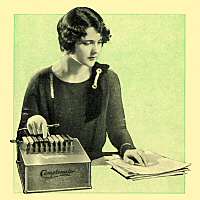
Dorr E Felt realised from the outset that the success of his Comptometer, in anything beyond simple addition, was critically dependent on the skill of its operator and on the methods of calculation employed. Two of his first eight machines were dedicated to training, so that operators would be available as soon as the remaining machines were placed in industry.
With the first machines and operators established, Felt turned his attention to the methods of calculation. Rather than simply mechanising the traditional manual computations, he began to develop new and improved methods that would take full advantage of the possibilities offered by his new machine and the new "mechanical age". These efforts led to the detailed instruction and training manuals that soon accompanied the machines, and culminated in 1914 with the publication of his treatise on "Applied Mechanical Arithmetic as practised on the Comptometer". This 600-page volume addressed every conceivable business and commercial calculation and showed how it could be accomplished with minumum effort on the Comptometer.
Comptometer training schools were established in 1905 to formalise this operator training, and to teach the new methods of calculation. By the late 1920s there were over 100 Comptometer schools in the United States alone, and another 50 in overseas countries, producing around 20,000 operators per year. Similar schools were established by Burroughs for their key-driven calculator, and later by the Bell Punch Company for the Sumlock machines.
The Comptometer schools typically recruited young girls and (sometimes) men straight from school at about 16 years old. Training began with the basics of operating the machine, with plenty of adding practice to develop speed and strength. Students were then taught the procedures for subtraction, multiplication, and division, and for the calculation of percentages, proportions, pro-rata, and even square roots. In Commonwealth countries the training included extensive practice in Sterling currency calculations, and then in the terminology, units, and typical problems from a wide range of trades and industries. Students were provided with sets of charts and tables to assist with unit conversions, but were expected to remember the common conversion factors and to be able to perform many partial calculations by mental arithmetic. The questions in the final examination tested all of these abilities in depth, and would still present a serious challenge to anyone with an electronic calculator today.
On completion of the course, the Comptometer schools offered a free service to place graduates into industry. Some of the schools retained their best operators as demonstrators or to provide a temporary labour hire service, while others operated consultancies or a calculating bureau service. The Australian Comptometer agents operated an extensive bureau, with clients ranging from major city businesses to pastoral companies in regional areas. Operators were regularly dispatched to rural locations to assist with tallying the wheat harvests and wool clips. These extended services were an integral part of the Comptometer business model, which regarded staff, systems, and professional support as essential requirements for the success of the machines.
The schools maintained contact with their graduates through newsletters and social functions. During the 1920s a regular "Comptometer News" magazine was distributed from Chicago to the training schools around the world, often with the addition of a local supplement. Many of the friendships formed in the schools continued long afterwards, with Comptometer operators from the 1950s and 60s still holding regular social gatherings and reunions.
Comptometry as a profession declined during the late 1960s, as larger firms began to move to computers and data processing systems, and smaller firms adopted the do-it-yourself electronic calculators. The decline was hastened in Australia by the introduction of decimal currency in 1966, and by the progressive adoption of the metric measurement system during the 1970s. The skilled and experienced comptometrists were soon replaced by unskilled key-punch operators, and Felt's "mechanical arithemtic" was itself replaced by systems more suited to the electronic age.